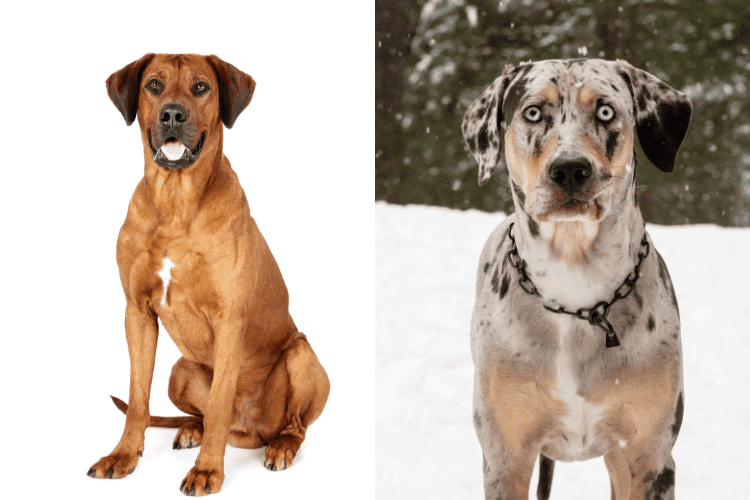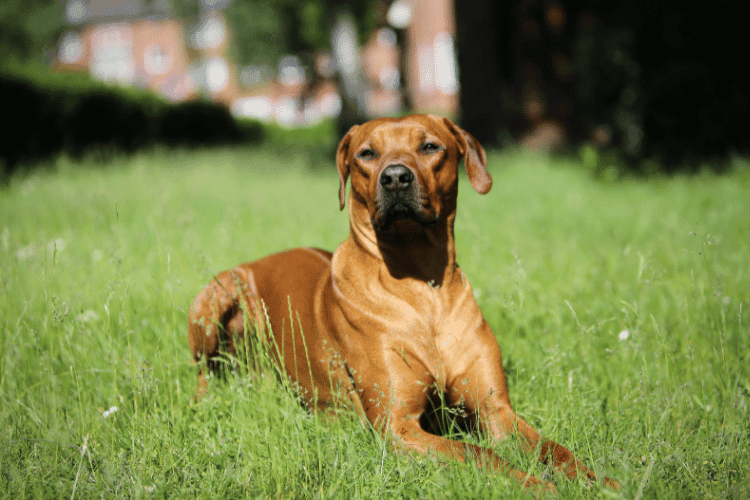A Rhodesian Ridgeback Catahoula Mix is a crossbreed resulting from breeding a Catahoula Leopard and a Rhodesian Ridgeback.
Considering that a Rhodesian Ridgeback Catahoula Mix is an offspring of working dogs, you should expect it to have similar traits. This breed is overflowing with energy, and they can sometimes get feisty.

Temperament of a Rhodesian Ridgeback Catahoula Mix
Rhodesian Ridgeback Catahoula Mixes are high-spirited, so they always have to move a lot. An active lifestyle is necessary for them to thrive and remain healthy.
These dogs can get a little hard to deal with if you live in an apartment due to their lifestyle. However, if you're living in a spacious house, you won't have any problems with these dogs!
1. Overflowing with Energy
Keeping your dog's brain stimulated is the key to its happiness.
A Rhodesian Ridgeback Catahoula Mix has the instinct to do things independently whenever it experiences boredom. Activities can range anywhere from playing with toys to destroying your belongings.
An excellent way to keep your dog busy is by playing with them and taking them out for walks and exercises. You'll burn their energy this way, leaving them little to no room for destructive behavior.
Another way to mentally stimulate your Rhodeissssian Ridgeback Catahoula is through trick training.
Whenever you train your dog, it's vital to reinforce them positively because it makes them more likely to repeat the behavior.
2. Loyalty to Their Owners
A Rhodesian Ridgeback Catahoula Mix loves to give its owners loyalty and dedication. As such, it's common for your dog to follow you wherever you go.
This trait got passed down to the breed from the Catahoula Leopard and the Rhodesian Ridgeback. Since the two breeds are herding and hound dogs, they heavily rely on their pack leaders.
So, it's essential to establish that you're the leader so that it'll follow your commands without hesitations.
Remember that a harmonious relationship with your Rhodesian Ridgeback Catahoula equates to a lower risk of them getting used to problematic behavior.
However, your dog's loyalty can become a problem if you often leave your house. Leaving them alone causes separation anxiety.
You can prevent this from happening if you're already getting your puppy used to the concept of being alone. In the case that your dog develops separation anxiety, you should consider hiring a dog sitter or leaving your canine at a doggy daycare.
3. Aware of Surroundings

A Rhodesian Ridgeback Catahoula Mix is always wary of its surroundings. If the dog sees someone they're unfamiliar with, it'll bark and show signs of aggression.
Unfortunately, this behavior is harder to deal with if your Rhodesian Ridgeback Catahoula Mix is already an adult. Older dogs tend to become more reluctant to new experiences.
So, early socialization is a crucial factor in the growth of your Rhodesian Ridgeback Catahoula Mix because it's the only method to get your dog used to new faces and other dogs.
Ideally, you should start the socialization process when you get your Rhodesian Ridgeback Catahoula Mix.
Don't fret because it's still possible for adult dogs to socialize! You can still get them used to other people by helping them acclimate to new experiences through positive reinforcement.
4. Even-Tempered
Luckily, Rhodesian Ridgeback Catahoula Mixes are even-tempered. They're usually calm most of the time, and they're rather friendly toward family members.
Moreover, there are times wherein they’re affectionate and enthusiastic, which makes them fantastic companions.
However, like other dog breeds, you shouldn't leave them unsupervised when they're around children. After all, they're quite large and tend to become assertive, so supervision is necessary.
Physical Appearance of a Rhodesian Ridgeback Catahoula Mix
A Rhodesian Ridgeback Catahoula Mix is a medium to large dog. This breed can grow up to 26 inches and weigh anywhere between 60 to 90 lbs. Furthermore, they have short yet shiny coats.
Their coat colors are a blend of Catahoula Leopards and Rhodesian Ridgebacks. It can be wheat, red, black, or merle.
Considering that the breed hasn't received recognition from the American Kennel Club yet, we're still unsure of their other possible colors.
Training a Rhodesian Ridgeback Catahoula Mix
Rhodesian Ridgeback Catahoula Mixes are intelligent dogs, and you can train them easily.
Agility training is your best choice to improve your communication with your dog. It also enhances the overall physical condition of your Rhodesian Ridgeback Catahoula Mix because it works out all of their muscles.
On the other hand, obedience training prevents temperament and behavior problems in your dog. Moreover, it strengthens the bond between you and your Rhodesian Ridgeback Catahoula Mix.
Grooming Requirements of a Rhodesian Ridgeback Catahoula Mix
Despite having short coats, Rhodesian Ridgeback Catahoula Mixes shed. Their grooming needs are minimal because regular brushing and occasional baths will do.
Brushing removes all loose hairs and helps retain the shine of their coat. On the other hand, bathing them at least once every week keeps them clean, especially whenever you take them out.
Other than those two methods, there aren't other grooming steps required. Bringing them to a professional groomer is completely optional.
How Long Should a Rhodesian Ridgeback Catahoula Mix Exercise?
Ideally, your Rhodesian Ridgeback Catahoula Mix should exercise for at least an hour daily. You can divide it into long walks with breaks in between.
Another method is by letting them play with toys that test their agility, such as frisbees. You can also try letting them play with puzzles, like Kongs.
Common Health Problems of a Rhodesian Ridgeback Catahoula Mix
A Rhodesian Ridgeback Catahoula Mix is prone to diseases that affect their joints, spine, as well as their eyes.
Hip Dysplasia is quite common among this breed. This is an inherited disease that causes the joints to form improperly, which leads to arthritis.
Furthermore, your dog can also get wobbler syndrome. It's a disease that compresses the cervical spine of your dog, which causes nervous system deficits.
Lastly, the breed is at a higher risk of developing eye problems, such as cataracts, entropion, and distichiasis.
However, with proper care and exercise, your dog can prevent some of these problems.

Calvin is the co-founder and one of the main contributors to dogtemperament.com. He has been an avid dog lover all his life. He enjoys researching and sharing great ideas on how you can avoid common pitfalls of dog ownership and build the most loving and enjoyable relationship with your dog.
Looking for a Dog Breed Price that Meets Your Budget?
Check out our